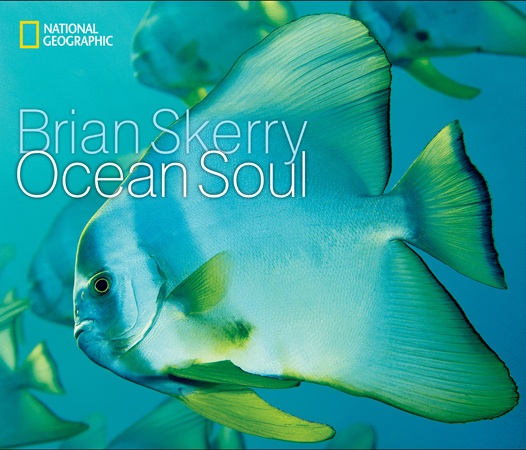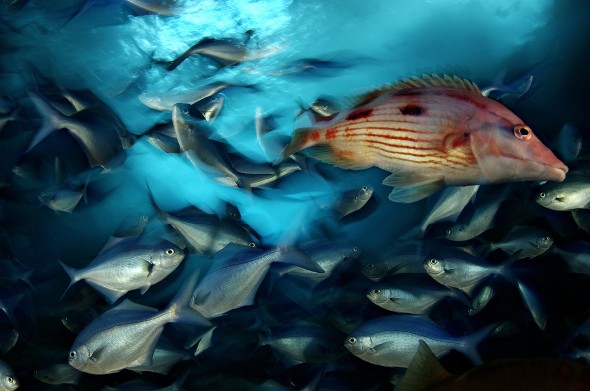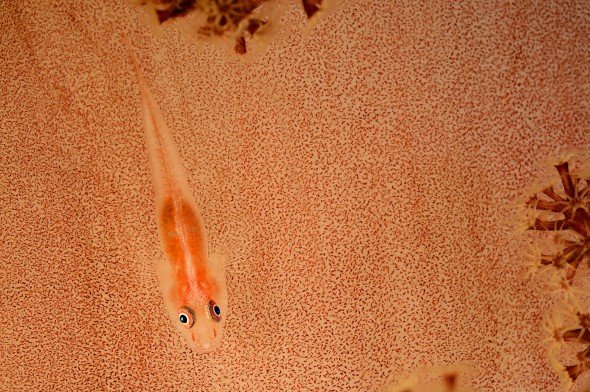 In the second installment of my chat with oceans photographer, Brian Skerry, I ask him about how he goes about capturing ocean soul on camera. And Brian gives the inside scoop on shooting pictures for National Geographic.
In the second installment of my chat with oceans photographer, Brian Skerry, I ask him about how he goes about capturing ocean soul on camera. And Brian gives the inside scoop on shooting pictures for National Geographic.
Helen: What goes through your mind when you’re underwater with your camera?
Brian: Depending on the dive, many things are probably going through my mind. I believe I have a bit of OCD, Obsessive Compulsive Disorder. I often get a song in my head that repeats over and over again. I can remember back when I was just starting diving, in my early teens, I’d be down in the waters here in New England, and I can always remember having songs in my head.
Today, all of my dives are working dives where I’m trying to produce pictures for stories, so in between those songs I’m also thinking very much about the kinds of pictures that I need to make, and I’m often thinking about the people back at National Geographic who ultimately will be judging these photographs for publication. First and foremost in my mind is probably my picture editor, Kathy Moran, who I work very closely with. I’m down there on the front line, seeing these things, and trying to make sense of it all underwater, and make an interesting photograph.
Helen: Some of your images appear very ‘artistic’ (I’m not sure that’s the right word, but hopefully you know what I’m getting at). How do you achieve that?
It hasn’t come about by accident, I’ve worked at it of course. I’ve looked at other photographers and I’ve trained myself to find those moments wherever I am in the ocean, and it doesn’t always happen.
If I go down on a coral reef it’s often chaos at first, I see all these things moving around, there’s all these fish, and behaviours going on, and I don’t understand it all. So I will often zero in on one thing, one behaviour. It could be as simple as a little blenny sticking its head out of a piece of coral to feed, or it could be a cleaning station, or something happening. I focus on that then slowly things begin to reveal themselves to me. I begin to see other things happening on the reef, but you’ve got to be observant, you’ve got to allow yourself time to see.
I write in Ocean Soul something along the lines of ‘I believe my most important role to be that of artistic interpreter. I need to understand the science but I want to capture the poetry.’ For me, that’s what it’s about.
Most people are not divers, and if we want to engage most people to care about the ocean we have to show them these themes, these animals and these ecosystems in a way that will be visually engaging. It’s one thing to go down and make a snapshot of a picture that records a moment, it’s another thing to try to bring in these visual elements of gesture and grace and light and colour and movement.
To me the ocean is this giant kaleidoscope that’s always moving with all of those things, and if I can make images that capture that spirit then I’ve achieved what I wanted to do.
Helen: Does everything we see happen in your camera?
Brian: Do I do any post production? Not really. We do very little. National Geographic, who I work mostly for, is very strict about how we do things. The photographers shooting digitally have to shoot in RAW format, which is the purest and most detailed form. We have to deliver all our pictures on a hard drive in sequence, we’re not even allowed to delete photos because they want to see everything we did. They want to make sure you didn’t set anything up or you’re faking or manipulating anything.
We can’t do any of the post production ourselves, only National Geographic do that. They will work with the photographer to make sure the colours and contrast are correct but they won’t manipulate anything beyond that, they won’t take anything out or put anything in. Like a negative you can dodge and burn, lighten and darken, because that raw file often comes out looking very flat. And sometimes there’s a colour cast, different cameras will have a blue cast, or a green cast. So you have to adjust the colours a little bit. Beyond that there’s no real adjustment. So I would say that the pictures you see are as I saw them.
Helen: Ok, here’s a slightly silly question: Do you ever get sea sick?
Brian: Not a silly question at all. I’ve never really been seasick. I’ve come close a couple of times but I’ve been very lucky. In 35 years of going to sea and diving, I’ve never really had a serious bout of seasickness. There was one time in New Zealand, I was in fjordland in a boat that I’d chartered for 9 days, and it was this very confused sea that was coming at us from all different angles. I tried lying in my bunk and I was getting a little nauseous, so I came up to the bridge and focused on a point out at sea and managed to brave through it.
I’ve been pretty lucky, I know a lot of my colleagues, even a lot of my assistants, suffer from seasickness, and they have to put patches on and do all these things. I’ve very lucky I don’t have to do that so far.
Next time, in the final installment of my chat with Brian Skerry about his work and his book Ocean Soul, I ask him to cast an eye forward and consider the future of the oceans.



Leave a Reply